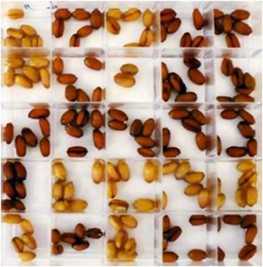This application case shows the utility of KnetMiner for the functional analysis of a transcriptomics (RNA-Seq) experiment in bread wheat (Triticum aestivum). Wheat is the third most-grown cereal crop in the world after maize and rice and has a hexaploid genome 5 times the size of the human genome.

The red colour of the grain is due to the presence of coloured compounds, called flavonoids, in the seed coat (bran). These flavonoids give wholemeal bread not only its colour, but also a slightly bitter taste which is disliked by many people. Whitegrained wheat varieties lack the red compounds of the seed coat and are milder in flavour. However, white grains are prone to pre-harvest sprouting (PHS) which causes the grain to germinate before harvest and results in a loss of grain quality. It has been known for some time that PHS is associated with grain colour and that the red pigmentation of wheat grain is controlled by R genes on the long arms of chromosomes 3A, 3B, and 3D. In the last decade, the genetic basis of the relationship between grain colour and PHS has been studied and molecular characterisation showed the R gene is a Myb-type transcription factor responsible for transcriptional activation of genes (CHS, CHI, F3H and DFR) in the flavonoid biosynthesis pathway. However, the link between the R (Myb) gene and PHS is still unclear.
Here we demonstrate the utility of KnetMiner for analysing candidate genes from reverse genetics or transcriptomics studies and answering questions such as:
- Do any of these genes contribute to the expression of trait A (e.g. grain colour)?
- Do any of these genes contribute to the expression of trait B (e.g. PHS trait)?
- Which biological processes and pathways are underlying these traits?
- Are there common genes or mechanisms that influence both traits?
- Which other processes and traits will be affected by loss-of-function mutants?
This use case follows directly into several of the Exercises. Use the navigation bar on the left to head to Exercise 1 for more.
Some more biology
This normally comes after completing Example 3.
The knowledge network of wheat MYB1/ TT2 contains gene regulatory information, protein-protein interactions, phenotypic information in the form of mutant/genetic studies or text-mining, links to relevant ontology terms and publications, and, similar information from Arabidopsis and other species. A more thorough exploration of the information (i.e. node and edge properties) captured in MYB1/ TT2 network tells the following detailed biological story:
MYB1/ TT2 (R Myb) on chromosome ‘3D’ in wheat is predicted (p-value = 0.01) to regulate the transcriptional activation of MFT according to data from the analysis of 850 RNA-Seq samples in wheat using GENIE3. The TT2 3B homeologue is not predicted to regulate MFT, and the TT2 3A homeologue is not annotated in the latest version of the wheat genome, MFT has been recently linked to grain germination [“Recent studies in both Arabidopsis and wheat have uncovered a new role of MOTHER OF FT AND TFL1 (MFT) in seed germination”] and seed dormancy [Mapping analysis showed that MFT on chromosome 3A (MFT-3A) colocalized with the seed dormancy quantitative trait locus (QTL) QPhs.ocs-3A.]. The MFT ortholog in Arabidopsis has a 3’ UTR variant that has been associated with (p-value=5.5×10-5) increased germination rate after 56 days of dry storage.
To discover which other traits will be affected by MYB1/ TT2 loss-of-function mutants, we can expand the initial MYB1/ TT2 knowledge graph (click the genes icon in the interactive legend) to add all other genes that are regulated by, or interact with, MYB1/ TT2. Other wheat genes regulated by MYB1/ TT2 don’t show any surprising phenotypes. However, the Arabidopsis MYB1/ TT2 interacts with TTG1; a gene known to be involved in controlling root hair density and root hair length in Arabidopsis root hairs. These root hairs are tubular outgrowths from specific epidermal cells, which have important roles in nutrient and water absorption. This interesting clue enables the creation of a speculative hypothesis that pre-harvest sprouting could be caused by increased root hairs, due to higher nutrient and water absorption in MYB1/ TT2 knock-outs. This is shown in the gene knowledge network of the MYB1/ TT2 (R Myb) gene.










